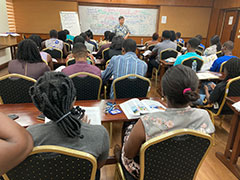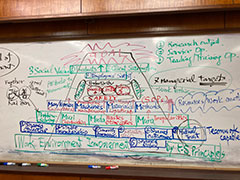Managerial skill training highlighting the “Pyramid of Organizational Management(POP)” and 5S-KAIZEN-TQM (2023-06-28)
5S Principles (Sort, Set, Shine, Standardise, Sustain) and KAIZEN are very familiar basic managerial tools that originated in the car industry of Japan. Those instruments are widely used in the manufacturing sector and service sector including healthcare industries around the world.
5S is a mode of work environment improvement. Based on the improved physical work environment, the teamwork maintained by work unit members creates opportunities for problem-solving by the staff for the staff and also for the benefit of internal and external clients. It affects very positively to uplift safety and quality of services.
The project invited Prof. Yujiro Handa, who has been working, since 1998, on the dissemination of 5S-KAIZEN-TQM approaches, a symbolic method for realizing participatory organizational management for healthcare facilities in developing country settings. For this purpose, the precondition of success is the strengthening of leadership at the respective organization. Medical research institutes are not an exception to tangible needs for further improvement of routine managerial practice carried out by all staff regardless of rank and category.
Noguchi Memorial Institute for Medical Research (NMIMR) is a leading research institute in Africa having many prominent researchers serving various specialities and capable technical/administrative staff. It is, therefore, stimulative to adopt a new approach (5S-KAIZEN-TQM) to NMIMR’s routine managerial practice for maximizing the capabilities of employees of all sorts.
The exposure seminar to POP and 5S-KAIZEN-TQM by Prof. Handa was held over three days, from 4th to 6th April 2023, with two sessions each day in the morning and afternoon, with a total of approximately 180 participants including heads of departments, quality managers, laboratory managers, and quality coordinators.
The seminar started with the question “What is management?” It was an opportunity to remind us once again what we aim for as an organization, what is necessary to achieve it, and where we should start. The introduction of case studies with many photographs from the field in developing countries gave us concrete hints on where to start.
All work units regardless of the category are expected to commence 5S activities at the possible earliest time as the essential entry point of quality improvement activities in each department. Department Quality teams formed at respective departments and units are expected to guide and lead the 5S activities. At one of the cold rooms in the Advanced Research Laboratories building a work improvement team (WIT) is formed over the departments and moves forward to have perfection in 5S activities. It is highly expected that small pilot activities at the mentioned location will become a useful showcase for other work units in the institute. Hopefully, the small onset of this movement becomes a stimulant to an organization-wide big movement.


